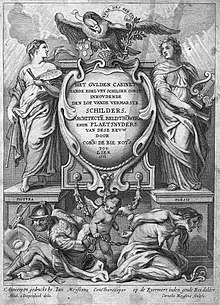Het Gulden Cabinet

Title page of the Gulden Cabinet
|
|
| Author | Cornelis de Bie |
|---|---|
| Country | Southern Netherlands |
| Language | Dutch |
| Subject | Artist biographies |
| Publisher | Jan Meyssen (1662) |
|
Publication date
|
1662 |
Het Gulden Cabinet vande Edel Vry Schilder-Const or The Golden Cabinet of the Noble Liberal Art of Painting is a book by the 17th-century Flemish notary and rederijker Cornelis de Bie published in Antwerp. Written in the Dutch language, it contains artist biographies and panegyrics with engraved portraits of 16th- and 17th-century artists, predominantly from the Southern Netherlands. The work is a very important source of information on the artists it describes. It formed the principal source of information for later art historians such as Arnold Houbraken and Jacob Campo Weyerman. It was published in 1662, although the work also mentions 1661 as date of publication.
Het Gulden Cabinet stands in a long tradition of artist biographies. This tradition goes back to Pliny and was revived during the Renaissance. In 1550, the Italian Giorgio Vasari published his Vite on the lives of famous artists. Karel van Mander was the first author to introduce this genre in the Dutch language with his Schilder-boeck of 1604. Cornelis de Bie explicitly placed himself in the tradition of van Mander and did what van Mander did for 15th and 16th Netherlandish artists for 17th-century artists.
In his Het Gulden Cabinet, de Bie presents himself as a rederijker whose duty it is to broadcast the fame of the artists. By doing so he followed an existing tradition already seen in Dominicus Lampsonius' 1572 Pictorum aliquot celebrium Germaniae Inferioris effigies and the Antwerp painter and rederijker Alexander van Fornenbergh's 1658 Antwerpschen Proteus ofte Cyclopschen Apelles, which sang the praises of the painter Quinten Matsys.
The concept of Het Gulden Cabinet did not come from Cornelis de Bie himself, but from the Antwerp printer Jan Meyssen. In 1649 Meyssen had already published Image de divers hommes, which contained engraved portraits of famous men, including painters, in imitation of Anthony van Dyck's Iconography. Most of the artist portraits in Het Gulden Cabinet are taken from this Image de divers hommes and only a few new engravings were made especially for de Bie's work.
...
Wikipedia
